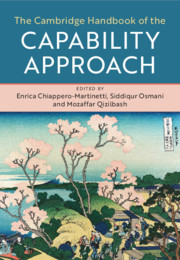Book contents
- The Cambridge Handbook of the Capability Approach
- The Cambridge Handbook of the Capability Approach
- Copyright page
- Dedication
- Contents
- Figures
- Tables
- Contributors
- Foreword
- Acknowledgements
- General Introduction
- Part I Historical Antecedents and Philosophical Debates
- Part II Methods, Measurement and Empirical Evidence
- Introduction to Part II
- 13 Social Choice and the Capability Approach
- 14 On Capability and its Measurement
- 15 Analyzing Capabilities
- 16 Implementing the Capability Approach with Respect for Individual Valuations
- 17 Capability, Opportunity, Outcome and Equality
- 18 The Distribution of Capabilities
- 19 Inter-Group Disparities in the Distribution of Human Development
- 20 Multidimensional Inequality and Human Development
- 21 The Research Agenda on Multidimensional Poverty Measurement
- 22 Measuring Gender Inequality Using the Capability Approach
- 23 Econometric and Statistical Models for Operationalizing the Capability Approach
- 24 Expanding Capabilities through Participatory Action Research
- Part III Issues in Public Policy
- Index
- References
16 - Implementing the Capability Approach with Respect for Individual Valuations
An Illustration with Colombian Data
from Part II - Methods, Measurement and Empirical Evidence
Published online by Cambridge University Press: 11 November 2020
- The Cambridge Handbook of the Capability Approach
- The Cambridge Handbook of the Capability Approach
- Copyright page
- Dedication
- Contents
- Figures
- Tables
- Contributors
- Foreword
- Acknowledgements
- General Introduction
- Part I Historical Antecedents and Philosophical Debates
- Part II Methods, Measurement and Empirical Evidence
- Introduction to Part II
- 13 Social Choice and the Capability Approach
- 14 On Capability and its Measurement
- 15 Analyzing Capabilities
- 16 Implementing the Capability Approach with Respect for Individual Valuations
- 17 Capability, Opportunity, Outcome and Equality
- 18 The Distribution of Capabilities
- 19 Inter-Group Disparities in the Distribution of Human Development
- 20 Multidimensional Inequality and Human Development
- 21 The Research Agenda on Multidimensional Poverty Measurement
- 22 Measuring Gender Inequality Using the Capability Approach
- 23 Econometric and Statistical Models for Operationalizing the Capability Approach
- 24 Expanding Capabilities through Participatory Action Research
- Part III Issues in Public Policy
- Index
- References
Summary
In many applications of the capability approach it is necessary to rank individuals with respect to their well-being. This raises the difficult question of how to select the weights to be attached to the relevant functionings or capabilities that constitute well-being. In this chapter, we explore the possibility of using individual valuations to set these weights and we propose to use equivalent income as a specific well-being measure that is consistent with these individual valuations. We discuss its implementation and compare the results to four alternative well-being measures based on Colombian data for 2008: income, subjective well-being, the official SISBEN index, and the Colombian Multidimensional Poverty Index (CMPI). To do that, we estimate the valuations of the individuals using a life satisfaction equation. We find that there is remarkably little overlap between the alternative measures when used to identify the worst-off. The different well-being measures identify different individuals as worst-off. The equivalent income measure identifies individuals with a lower income, who are in worse health, live in a house of lower value and have a larger chance of being unemployed. This finding highlights the empirical relevance of the selection of the well-being measure when implementing the capability approach.
- Type
- Chapter
- Information
- The Cambridge Handbook of the Capability Approach , pp. 307 - 332Publisher: Cambridge University PressPrint publication year: 2020

